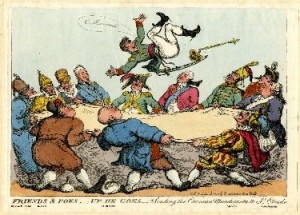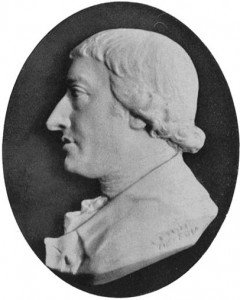Reading Francis Douce’s correspondence sometimes feels like playing six degrees of separation. Douce, for instance, knew Twiss, whose friend Alexander Jardine corresponded with Gaspar Melchor de Jovellanos, one of Goya’s patrons. Twiss’s letters are a particularly rich source of information to reconstruct this sort of indirect relationships. My favourite case of remote acquaintance is Rudolph Erich Raspe (1737 – 1794), whom Twiss mentions in a letter to Douce dated 29 November 1788:
I have found the Italian Philicolo, & Saladino’s Novels, & shall copy the passages I want on Tuesday at 11 o’clock. Then I shall go to Mr. Thorkelin (to whom I have now written a note) from thence to Mr. Raspe, from whom I shall pick up something else & then to you.
Raspe’s name appears again in Twiss’s letters in May 1789, shortly before the German author travelled to the Hebrides ‘to explore some mines for the Duke of Argyll’. According to his first biographer John Carswell, Raspe was an adventurer and an opportunistic rogue, now best remembered as the author of the Baron Munchausen’s Narrative of his Marvellous Travels and Campaigns in Russia, published anonymously in 1786. Munchausen’s name was soon being used to ridicule the hyperactive imaginations of armchair travellers, experimental farmers and over-ambitious rulers:

Thomas Rowlandson, Friends & foes-up he goes-sending the Corsican Munchausen to St Cloud's, 1813 (photo: The British Museum)
The author of this satirical print, Thomas Rowlandson, also signed the illustrations to a spurious Surprising adventures of the renowned Baron Munchausen, published by Thomas Tegg in 1809. Douce enjoyed Rowlandson’s raucous sense of humour and he acquired many of his lively drawings, which are now part of the Ashmolean’s collection.
Munchausen’s name could also be used to satirise the perils of what the editor of the Farmer’s Magazine called ‘analogical reasoning’. As he explained in his footnote to a communication entitled ‘The Baron Munchausen, greeting!’ sent by an anonymous contributor in 1803:
We apprehend the intention of our present correspondent […] to ridicule […] that abuse of analogical reasoning, from which wonderful conclusions are often speciously inferred, or asserted directly as facts, though not warranted by their fair verification of actual experiment.
Less well known is Raspe’s work for the Scottish medallionist James Tassie. In 1791, Raspe published A Descriptive Catalogue of a General Collection of Ancient and Modern engraved Gems, Cameos as well as Intaglios, taken from the most celebrated Cabinets in Europe; cast in coloured Pastes, white Enamel and Sulphur, by James Tassie, Modeller. Douce knew Tassie’s nephew William, who took over the business in 1799, and he probably owned a copy of the catalogue. Interestingly, in the preface Raspe refers to the connections between what he calls ‘the Lapidary’s art’ and engraving, which lead him to write at length on the origins of printmaking.

